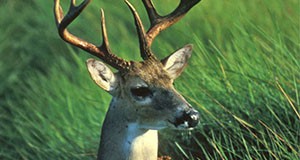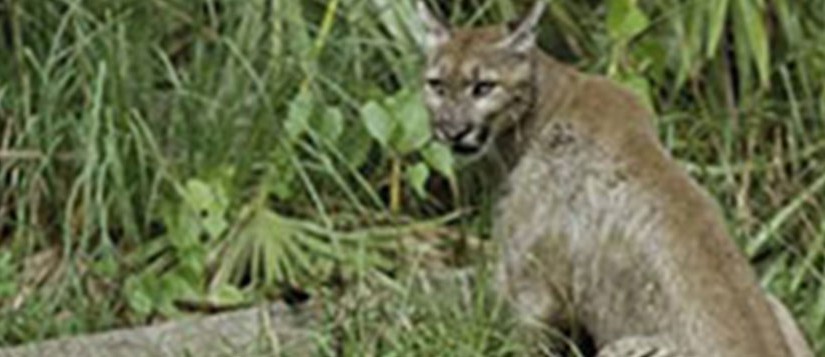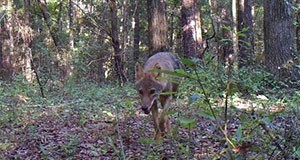 The omnivorous coyote is a relative newcomer to Florida that plays an important role in ecosystems and food webs. Of particular importance and possible benefit may be their potential ability to control populations of pest species such as some rodents. Although rare, there are situations where coyotes can become dangerous or damaging. In this 4-page fact sheet, we present some facts about coyotes, describe dangers and problems they may cause, and provide suggestions on how to cope with these issues. Written by Lauren Watine, William M. Giuliano, Holly K. Ober, Raoul Boughton, Alexander Gulde, Angeline Scotten, and published by the UF Department of Wildlife Ecology and Conservation, December 2014. (Photo: W. M. Giuliano, UF/IFAS)
The omnivorous coyote is a relative newcomer to Florida that plays an important role in ecosystems and food webs. Of particular importance and possible benefit may be their potential ability to control populations of pest species such as some rodents. Although rare, there are situations where coyotes can become dangerous or damaging. In this 4-page fact sheet, we present some facts about coyotes, describe dangers and problems they may cause, and provide suggestions on how to cope with these issues. Written by Lauren Watine, William M. Giuliano, Holly K. Ober, Raoul Boughton, Alexander Gulde, Angeline Scotten, and published by the UF Department of Wildlife Ecology and Conservation, December 2014. (Photo: W. M. Giuliano, UF/IFAS)
http://edis.ifas.ufl.edu/uw397
Tag: Lauren Watine
Managing Conflicts with Wildlife: Living with Deer
Though deer rarely pose problems for people, it is important to understand the issues associated with deer and human-deer interactions. This 4-page fact sheet describes the biology of Florida’s white-tailed deer, the hazards associated with deer, and how to minimize these risks. Written by William M. Giuliano, Holly K. Ober, Lauren Watine, and Raoul Boughton, and published by the UF Department of Wildlife Ecology and Conservation, December 2014.
http://edis.ifas.ufl.edu/uw398
Managing Conflicts with Wildlife: Living with Panthers
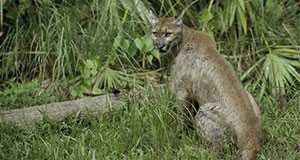 Panthers help maintain populations of some native species and control nuisance species such as wild hogs. They are generally secretive and rarely bother people, but there are rare situations where panthers can become dangerous or damaging. In this 4-page fact sheet, we present some facts about panthers, describe dangers and problems they may cause, and provide suggestions on how to cope with these issues. Written by William M. Giuliano, Holly K. Ober, Lauren Watine, Raoul Boughton, Eric Hellgren, Darrell Land, and Mark Lotz, and published by the UF Department of Wildlife Ecology and Conservation, December 2014.
Panthers help maintain populations of some native species and control nuisance species such as wild hogs. They are generally secretive and rarely bother people, but there are rare situations where panthers can become dangerous or damaging. In this 4-page fact sheet, we present some facts about panthers, describe dangers and problems they may cause, and provide suggestions on how to cope with these issues. Written by William M. Giuliano, Holly K. Ober, Lauren Watine, Raoul Boughton, Eric Hellgren, Darrell Land, and Mark Lotz, and published by the UF Department of Wildlife Ecology and Conservation, December 2014.
http://edis.ifas.ufl.edu/uw399
Managing Conflicts with Wildlife: Living with Wild Hogs
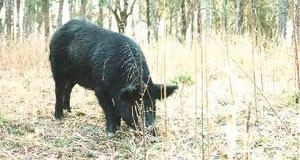 Wild hogs are a popular species, pursued and hunted by many throughout Florida. They are also an important food source for the endangered Florida panther.
Wild hogs are a popular species, pursued and hunted by many throughout Florida. They are also an important food source for the endangered Florida panther.
But there are situations where they can become dangerous or damaging. In this 4-page fact sheet, we present some facts about hogs, describe dangers and problems they may cause, and provide suggestions on how to cope with these issues. Written by William M. Giuliano, Holly K. Ober, Lauren Watine, Raoul Boughton, and Don Coyner, and published by the UF Department of Wildlife Ecology and Conservation, December 2014. (Photo: M.S. Smith)
http://edis.ifas.ufl.edu/uw400
Managing Conflicts with Wildlife: Living with Bears
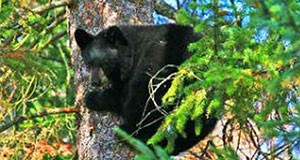 Black bears are omnivorous, enigmatic animals that help maintain healthy forests by dispersing seeds of plants they eat. Bear watching is a favorite pastime for many Floridians throughout the state. Bears are generally secretive and rarely a problem for people. But there are rare situations where they can become dangerous or damaging. In this 4-page fact sheet, we present some facts about bears, describe dangers and problems they may cause, and provide suggestions on how to cope with these issues. Written by William M. Giuliano, Holly K. Ober, Lauren Watine, Eric Hellgren, Raoul Boughton, and Dave Telesco, and published by the UF Department of Wildlife Ecology and Conservation, December 2014.
Black bears are omnivorous, enigmatic animals that help maintain healthy forests by dispersing seeds of plants they eat. Bear watching is a favorite pastime for many Floridians throughout the state. Bears are generally secretive and rarely a problem for people. But there are rare situations where they can become dangerous or damaging. In this 4-page fact sheet, we present some facts about bears, describe dangers and problems they may cause, and provide suggestions on how to cope with these issues. Written by William M. Giuliano, Holly K. Ober, Lauren Watine, Eric Hellgren, Raoul Boughton, and Dave Telesco, and published by the UF Department of Wildlife Ecology and Conservation, December 2014.
http://edis.ifas.ufl.edu/uw396
Freshwater Turtles of Belize (WEC328/UW373)
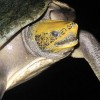 Belize, a country rich in natural resources and diverse wildlife, is home to nine species of freshwater turtles. Among these is the critically endangered hicatee, which has been eliminated in most of its range as a result of hunting and habitat loss. Freshwater turtles live in rivers, creeks, and lagoons, and build their nests on the banks. They eat a variety of plants, aquatic vegetation, and fruits. However, little is known about Belize’s unique turtle species. This 2-page fact sheet will help people identify, understand, and conserve these treasured resources. Written by Venetia Briggs, Lauren Watine, Dustin Smith, Robin Bijlani, Rebecca Harvey, William Giuliano, and Frank Mazzotti, and published by the UF Department of Wildlife Ecology and Conservation, January 2013.
Belize, a country rich in natural resources and diverse wildlife, is home to nine species of freshwater turtles. Among these is the critically endangered hicatee, which has been eliminated in most of its range as a result of hunting and habitat loss. Freshwater turtles live in rivers, creeks, and lagoons, and build their nests on the banks. They eat a variety of plants, aquatic vegetation, and fruits. However, little is known about Belize’s unique turtle species. This 2-page fact sheet will help people identify, understand, and conserve these treasured resources. Written by Venetia Briggs, Lauren Watine, Dustin Smith, Robin Bijlani, Rebecca Harvey, William Giuliano, and Frank Mazzotti, and published by the UF Department of Wildlife Ecology and Conservation, January 2013.
http://edis.ifas.ufl.edu/uw373
Tips for Integrating Land and Wildlife Management: Quail and Timber (WEC331/UW376)
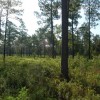 In Florida, changes in forest management practices during the past 50+ years have led to declines in quail habitat and populations. Important changes involve the use of fire and conversion of native forests to commercial pine plantations. A lack of fire and other disturbance has often led to closed-canopy forests with dense undergrowth that lack important quail habitat components. This 2-page fact sheet provides several quail habitat improvement tips that focus on diversifying the plant species and structural composition and increasing early successional communities dominated by herbaceous plants. Written by William M. Giuliano and Lauren Watine, and published by the UF Department of Wildlife Ecology and Conservation, January 2013.
In Florida, changes in forest management practices during the past 50+ years have led to declines in quail habitat and populations. Important changes involve the use of fire and conversion of native forests to commercial pine plantations. A lack of fire and other disturbance has often led to closed-canopy forests with dense undergrowth that lack important quail habitat components. This 2-page fact sheet provides several quail habitat improvement tips that focus on diversifying the plant species and structural composition and increasing early successional communities dominated by herbaceous plants. Written by William M. Giuliano and Lauren Watine, and published by the UF Department of Wildlife Ecology and Conservation, January 2013.
http://edis.ifas.ufl.edu/uw376
Tips for Integrating Land and Wildlife Management: Quail in Cattle Country (WEC332/UW377)
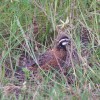 This 2-page fact sheet provides specific tips to improve quail habitat in cattle country that focus on diversifying the plant species and structural composition and increasing early successional communities dominated by herbaceous plants. Written by William M. Giuliano and Lauren Watine, and published by the UF Department of Wildlife Ecology and Conservation, January 2013.
This 2-page fact sheet provides specific tips to improve quail habitat in cattle country that focus on diversifying the plant species and structural composition and increasing early successional communities dominated by herbaceous plants. Written by William M. Giuliano and Lauren Watine, and published by the UF Department of Wildlife Ecology and Conservation, January 2013.
http://edis.ifas.ufl.edu/uw377
